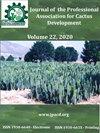在仙人掌离聚体的子空间中,大量营养平衡成分会使结果最大化吗?
IF 0.4
4区 农林科学
Q4 HORTICULTURE
Journal of the Professional Association for Cactus Development
Pub Date : 2022-11-05
DOI:10.56890/jpacd.v24i.512
引用次数: 0
摘要
目前关于仙人掌营养需求的知识存在重要的局限性。作为标准提出的宏观营养素平均浓度没有考虑元素之间(或元素之间)的平衡,可用的成分营养素诊断标准也没有易于估计的正交参考文献支持。我们假设印度榕树植物在生产果实的平衡成分方面具有宏观营养需求。等距对数比使我们能够测试O.ficus indica品种“Rojo Pelón”植物在其1年生分支中的真负(T-n)或宏观营养平衡成分的基础上最大限度地提高果实产量。这些T-N组成可以使用两个最佳定界符以直接的方式进行估计,即,与类平方和的最高值相关的相关等距对数比上的Mahalanobis距离,以及先前定义的目标产量。当用作靶标时,这些平衡成分使我们能够确定真正的阳性成分的特征是P缺乏和N奢侈消费。应开发基于正确诊断解释的新技术来执行适当的建议,以客观地解决所需的变化,从而提高真阳性不平衡成分的营养状况。本文章由计算机程序翻译,如有差异,请以英文原文为准。
Do macro-nutrient balanced compositions in a subspace of the ionome of Opuntia ficus-indica (L.) Miller maximize fruiting?
The current state of knowledge on Opuntia ficus-indica nutrient requirements has important limitations. Macro-nutrient mean concentrations proposed as standards do not consider balances between (or among) elements, and the available compositional nutrient diagnosis norms are not supported by orthogonal references easy to estimate. We hypothesize that O. ficus-indica plants pose macro-nutrient requirements in terms of balanced compositions for producing fruits. The isometric log-ratios allowed us to test that O. ficus-indica variety ‘Rojo Pelón’ plants maximize fruit yield under the basis of true-negative (T-N) or macro-nutrient-balanced compositions in their 1-year-old cladodes. These T-N compositions can be estimated in a straightforward manner using two optimal delimiters, that is, the Mahalanobis distance across the involved isometric log-ratios linked with the highest value of Class Sum of Squares, and a target yield previously defined. When used as a target, these balanced compositions allowed us to identify that true-positive compositions were characterized by P deficiencies and N luxurious consumptions. Novel techniques to perform suitable recommendations based on correct diagnosis interpretation should be developed to address objectively the needed change to enhance the nutrient status of true-positive imbalanced compositions.
求助全文
通过发布文献求助,成功后即可免费获取论文全文。
去求助
来源期刊

Journal of the Professional Association for Cactus Development
Agricultural and Biological Sciences-Plant Science
CiteScore
1.10
自引率
33.30%
发文量
10
期刊介绍:
The editors of the Journal of the Professional Association for Cactus Development, are very excited to be a part of the excellent editorial committee and to work together to create the synergism between scientists, growers, legislators, and business people so vital to the development of this industry to serve the people of arid lands.
 求助内容:
求助内容: 应助结果提醒方式:
应助结果提醒方式:


